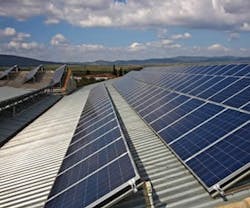Roof Loads and Solar Energy
Thanks to improvements in technology performance and installation best practices – along with decreased costs, robust financial incentives, and creative financing options, like power purchase agreements – installing a solar energy system is more feasible than ever. As a result, solar will be in high demand for the retrofit projects and new construction projects you’re working on. For your next building project, make sure you consider the cost of designing the building so it can safely hold the weight of a solar energy system in case your client ever decides to install one.
How it Worked
In the early 1980s, it was customary to use simple comparative ratios to evaluate the economics of various schematic roof designs, and then use this data to prepare early estimates of building component quantities (specifically, the quantity and weight of steel).
Engineers provided schematic values to construction managers so they could begin formatting initial construction budgets early on. The data had to be accurate – even the slightest discrepancy (of even just a few cents) could mean thousands of dollars in overruns later. Today, a similar approach can be taken when designing buildings to support photovoltaic systems.
Accuracy is Critical
The accurate calculations of costs in pre-design for new construction projects are extremely critical because solar impacts the load of a soon-to-be-built structure. Generally speaking, architects, designers, and contractors don’t accurately account for the true costs of structural requirements for solar in the early stages, so projects move forward without solar (or it’s more expensive to install later).
Almost all solar energy solutions involve:
• Solar modules (panels).
• Racking systems (the structure connected to the roof, where the modules are fastened and secured).
• Inverters (the piece of equipment that converts DC electricity into AC electricity).
Historically, preliminary designs called for approximately 5 to 6 pounds of roof steel per square foot of roof area (including joists, beams, and columns). This amount of steel typically supports a total roof load of about 50 pounds per square foot. This is the sum of a 20-pounds-per-square-foot dead load (including a ballasted membrane roof, which was typical for roofs on shopping centers in the early 1980s, for example); for a roof live load (or snow load in some areas of the country), it’s a sum of approximately 30 pounds per square foot. Using these figures, it’s possible to estimate that it takes about 1 pound of steel (per square foot) to support every 10 pounds of design roof load (per square foot).
Today’s Calculations
Given this as a historical-data starting point, and assuming that this comparative analysis remains reasonable, the weight of a ballasted photovoltaic solar system is approximately 4.5 to 6 pounds per square foot. The actual weight depends on the system’s location on the roof, the tilt of the modules (typically 5 to 20 degrees), and the height above the ground. Another way to interpret this data is to say that a typical solar installation (i.e. not thin film) will require approximately 0.5 pounds of roof steel per square foot. Thin film solar weighs quite a bit less, but it’s less efficient; therefore, a much greater quantity is required.
As for variables, it’s true that the cost of steel tends to fluctuate significantly across different regions. There are also variables in fabrication, delivery, and erection of steel that increases costs. If architects and designers assume that the added cost of steel needed to support a solar power installation is based on the raw cost of steel, it might be reasonable to make the following analysis to determine the cost impact associated with designing the roof structure to support the future installation of a photovoltaic system.
Estimating the cost of structural steel at $1,500 per ton ($0.75 per pound), and further estimating that the raw cost of the steel is approximately 45 percent of the total cost (the rest being engineering, fabrication, shipping, and erection), it can be assumed that the actual cost of the steel is approximately $0.34 per pound.
This would indicate that it costs approximately $0.17 per square foot to build a facility designed with the capability to support a photovoltaic installation. Expecting that the overall building development costs probably range from $35 to $200 per square foot of building constructed (or more, depending on the use, type, location, etc.), solar represents just a small fraction of overall cost.
James E. Trant is a structural engineer at Borrego Solar Systems (www.borregosolar.com).
